In the third of our YourStreet articles, Ben takes us on a historical ride along the Alton Towers Railway.
Our journey starts with the building of the railway in 1952 and finishes off with the closure of the line at the end of the 1996 season. We will be stopping along the way to reflect on the changes which the railway underwent during it’s 54 year life span.
This is the first in a two part article about this much missed attraction. The train is pulling into the station – It’s time to climb aboard the Alton Towers Railway!
The Building of a Railway
The grounds which surround Alton Towers, the historic house built by Charles Talbot (15th Earl of Shrewsbury), have been intermittently open to the public since 1829. Until 1892 the gardens were the sole attraction until they were supplemented by occasional summer fetes arranged by the owners of the house. In 1924, the house and grounds were sold off and the gradual transformation into a leisure site began. After requisitioning during World War II, the gardens around Alton Towers reopened to the public in 1952. It was during this time that the company began assembling new attractions. It is here that we first meet the Alton Towers Railway.
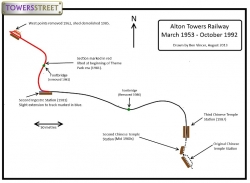 After sourcing locomotives and coaches, which will be covered in the second part of this article, the railway was laid throughout early 1953 ready for opening at Easter of the same year. Nearly 700 yards in length, the railway ran from the Ingestre Courtyard to a station near the Chinese Temple offering visitors a leisurely route into the gardens. The railway in this layout can be seen in Figure One. Both stations had run round loops which meant that the locomotive could always be on the front of the train. The loop at the Ingestre Station end ran through a shed; thus offering the rolling stock undercover storage when not in use. Both run around loops were removed in 1962, although the stock shed was left connected via the easterly set of points with operation becoming push/pull. Around this time the first shortening of the railway occurred, with a new station at the Chinese Temple being built on the curve immediately west of the original station.
After sourcing locomotives and coaches, which will be covered in the second part of this article, the railway was laid throughout early 1953 ready for opening at Easter of the same year. Nearly 700 yards in length, the railway ran from the Ingestre Courtyard to a station near the Chinese Temple offering visitors a leisurely route into the gardens. The railway in this layout can be seen in Figure One. Both stations had run round loops which meant that the locomotive could always be on the front of the train. The loop at the Ingestre Station end ran through a shed; thus offering the rolling stock undercover storage when not in use. Both run around loops were removed in 1962, although the stock shed was left connected via the easterly set of points with operation becoming push/pull. Around this time the first shortening of the railway occurred, with a new station at the Chinese Temple being built on the curve immediately west of the original station.
The First Major Changes
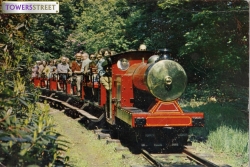 It was this arrangement in which the railway stayed the longest and an image of ‘Altonia’ running through the park can be seen in Figure Two. In 1981, Alton Towers added a log flume as part of its transition from amusement park to theme park and it was this addition which was to have the biggest impact on the railway. It was deemed unsafe to have the route of the railway crossing the queue of a popular ride and therefore the railway was cut back to a site to the south of the log flume’s lift hill. Despite serving as a truncated section of track for the 15” gauge locomotive John for several years, the original Ingestre end station was demolished in 1985 to make way for the extant Tea Cups ride and the Mississippi Showboat was placed on the site of the northern footbridge.
It was this arrangement in which the railway stayed the longest and an image of ‘Altonia’ running through the park can be seen in Figure Two. In 1981, Alton Towers added a log flume as part of its transition from amusement park to theme park and it was this addition which was to have the biggest impact on the railway. It was deemed unsafe to have the route of the railway crossing the queue of a popular ride and therefore the railway was cut back to a site to the south of the log flume’s lift hill. Despite serving as a truncated section of track for the 15” gauge locomotive John for several years, the original Ingestre end station was demolished in 1985 to make way for the extant Tea Cups ride and the Mississippi Showboat was placed on the site of the northern footbridge.
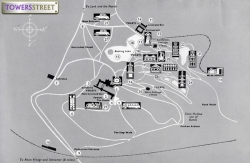 In the mid 1980s the route was shorted for a second time at the Chinese Temple end, moving to a third station which was further north and away from the original curved alignment. Using old park maps and guidebooks this shortening seems to have occurred at the beginning of 1986. Interestingly, despite being simple and pictorial, visitor guidebooks and maps of Alton Towers generally gave reasonable depictions of the railway’s track plan throughout its life. See Figure Three for an example from the 1960s.
In the mid 1980s the route was shorted for a second time at the Chinese Temple end, moving to a third station which was further north and away from the original curved alignment. Using old park maps and guidebooks this shortening seems to have occurred at the beginning of 1986. Interestingly, despite being simple and pictorial, visitor guidebooks and maps of Alton Towers generally gave reasonable depictions of the railway’s track plan throughout its life. See Figure Three for an example from the 1960s.
Major Changes Afoot
Having obtained two further locomotives under the new ownership of the Tussauds group, the railway was to undergo its biggest facelift in 1993. With increasing competition from the Skyride and a desire to improve the throughput of the railway, both stations were moved to new, larger locations and the line was relaid with two tracks throughout.
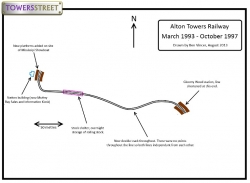 The two tracks were not linked and the lines were operated independently from each other. Ironically, the station at the Ingestre End was built on the site of the Mississippi Riverboat, which had been placed on the original track bed from pre-1981. The station at the former Chinese Temple End was rebuilt to the same specifications in a new location underneath ‘Gloomy Wood’, the new area for 1992. This layout of the railway can be seen in Figure Four.
The two tracks were not linked and the lines were operated independently from each other. Ironically, the station at the Ingestre End was built on the site of the Mississippi Riverboat, which had been placed on the original track bed from pre-1981. The station at the former Chinese Temple End was rebuilt to the same specifications in a new location underneath ‘Gloomy Wood’, the new area for 1992. This layout of the railway can be seen in Figure Four.
Closure
This double track formation was to be the railway’s final layout as it was decided at the end of the 1996 season that the benefits of a service through the gardens to the eastern side of the park were now outweighed by the operational and safety costs. The line was left operable, with the locomotives and rolling stock stored underneath the corrugated metal roof which was built in the cutting adjacent to the first drop of the log flume until 2000. It was at the turn of the millennium that it was decided that the railway was not going to open again and all of the stock and track was lifted and sold off.
What remains of the railway today?
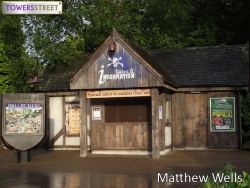 Although the railway was lifted at the turn of the millennium the track bed was left virtually untouched, simply sealed off from the rest of the park. This kept enthusiasts dreams of a railway revival alive until the route of the railway was reused as a brand new attraction for 2007. The ‘Haunted Hollow’, which was built during the winter of 2006, is a themed path which follows the course of the railway through the woods from Mutiny Bay to Gloomy Woods. Only a few features of the railway are still visible, an example being the brick lined cutting which was once covered by the corrugated metal roof. The station building at the Mutiny Bay (Ingestre) end still remains as the Sales and Information kiosk; however it has been extended across the old entrances to the platforms (Figure Five).
Although the railway was lifted at the turn of the millennium the track bed was left virtually untouched, simply sealed off from the rest of the park. This kept enthusiasts dreams of a railway revival alive until the route of the railway was reused as a brand new attraction for 2007. The ‘Haunted Hollow’, which was built during the winter of 2006, is a themed path which follows the course of the railway through the woods from Mutiny Bay to Gloomy Woods. Only a few features of the railway are still visible, an example being the brick lined cutting which was once covered by the corrugated metal roof. The station building at the Mutiny Bay (Ingestre) end still remains as the Sales and Information kiosk; however it has been extended across the old entrances to the platforms (Figure Five).
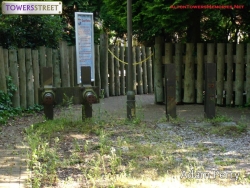 The brick platforms themselves remain behind the building complete with sprung buffers, a lampost and fences (Figure Six). Unfortunately no trace of the stations at the Gloomy Woods end remain.
The brick platforms themselves remain behind the building complete with sprung buffers, a lampost and fences (Figure Six). Unfortunately no trace of the stations at the Gloomy Woods end remain.
Unfortunately that is the end of our trip along the Alton Towers Railway for today but you can join Ben for the second part of his article where he will take us on a guided tour around the engine shed. Also discover where you can get a ride behind one of the ex-Alton Towers locomotives today!
References
Scott, P (1998), Minor Railway Histories: A history of the Alton Towers Railway, Reading: Peter Scott
The above book is the ultimate guide to the Alton Towers Railway – Unfortunately now out of print, if a second hand copy comes up on Amazon – it would come very highly recommended.
Scott, P (2002), Minor Railway Histories: A history of the Wicksteed Park Railway, Reading: Peter Scott
Weaver, R. (1975), Baguley Locomotives: 1914-31, London: Industrial Railway Society
Alton Towers (1957), Alton Towers Official Guide, Derby: Tresises Ltd.
Alton Towers (1961), Alton Towers Souvenir Guide Book, Nottingham: Ruddocks Advertising Ltd.
Alton Towers (1964), Alton Towers Souvenir Guide Book, Nottingham: Ruddocks Advertising Ltd.
Alton Towers (1967), Alton Towers Souvenir Guide Book, Nottingham: Ruddocks Advertising Ltd.
Alton Towers (1970), Alton Towers, Birmingham: Brandwood
Dixon, J.A. (No Date), Alton Towers, Staffordshire, The Miniature Railway [Photograph], Date Viewed: 28th August 2013.
Various Park Maps since 1980.
Images from – Matthew Wells and Adam Perry, Maps by Author


 Ben is interested in both the historical side and the more modern developments that occur at Alton Towers. His interests include narrow gauge railways and playing football.
Ben is interested in both the historical side and the more modern developments that occur at Alton Towers. His interests include narrow gauge railways and playing football.